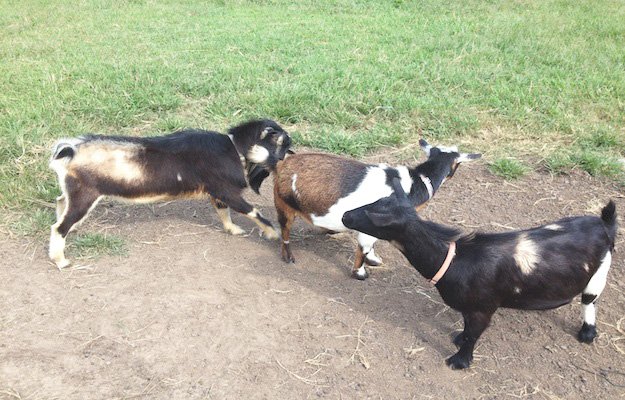Not sure if your goats are ready to mate? Watch for these 7 signs. This is part of our Homesteading Handbook For Raising Goats. Click here for the complete guide.
As the weather cools and the days shorten, goats that are monoestrous will begin to come into season, or cycle. This means that they are ready for breeding and can now be introduced to the buck.
7 Signs It's Goat Breeding Season
Generally, goats cycle every 18-21 days throughout breeding season, but this can vary from animal to animal.
The following signs can be indicators that your goat is cycling, and if you want to have kids, then this is the time to bring in the buck!
Watch for these signs:
Behavioral Changes to Identify Goat Breeding Season
Any changes in a goat’s behavior can also be signs of distress or illness, so it’s vital to keep a close watch on any does behaving oddly or out of character, or displaying different appetites to normal.
1. Acting ‘bucky’ is a sign it's Goat Breeding Season
This can involve does mounting each other, spitting, ‘blubbing’ like a buck in rut, and curling of the upper lip.

2. Flagging is a sign it's Goat Breeding Season
A wagging tail is also a sign of being in season. The doe will show this especially in the presence of a buck. This is known as flagging.
3. Peaked Interest is a sign it's Goat Breeding Season
If there is an adjoining fence between the does and the bucks, the bucks will more than likely start challenging your fences as the does line up with their butts towards the fence, wagging their tails.

4. Play Fighting is a sign it's Goat Breeding Season
If a doe is coming into season she may well play fight with her pasture mates. This often involves head-butting, rearing up and tottering towards each other on hind legs and coming down into a head butt, and lots of running around and kicking out of back legs. This is great fun to watch, especially when it’s your mature does who are acting like kids again!

5. Being very vocal is a sign it's Goat Breeding Season
Some goats let you know without a shadow of a doubt when they are cycling: congratulations, you got yourself a screamer. Does like this will call, incessantly, for a buck, the entire time they are in season. I have one like this, and I usually breed her right away, for the sake of the neighbors, my sanity and the other goats. She drives us all crazy with her yelling.
Physical Changes to Identify Goat Breeding Season
It’s important to observe your animals carefully to see when they are coming into season, and also to see whether they re-cycle after exposure to the buck; if so it may mean that they were not bred on their previous exposure.
6. Change in Color is a sign it's Goat Breeding Season
A red or swollen vulva is one of the most obvious signs of being in season.
7. Change in Bodily Fluids is a sign it's Goat Breeding Season
Discharge from the vulva, often a clear or whitish gel-like substance is also another sign that a doe is in heat.

Baby goats are wonderful addition to any farm, and with them comes MILK! Milk is the very best, because it can also be cheese, yogurt and ice cream.
Click here for a tasty list of recipes you can make from your goat milk.
Learn more about keeping goats here
Liked this? You'll also like
- Raising Backyard Chickens – Homesteading Handbook
- Ideas That Will Change The Way You Go Outdoors
- How to Bake Without Your Oven

Leave a Reply